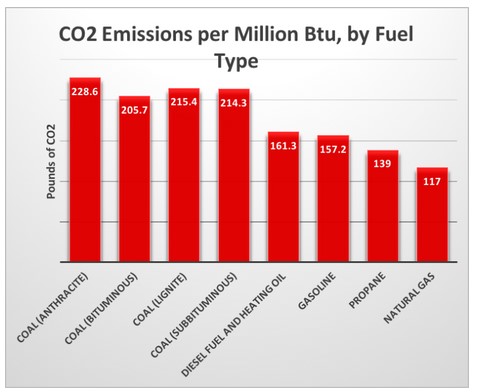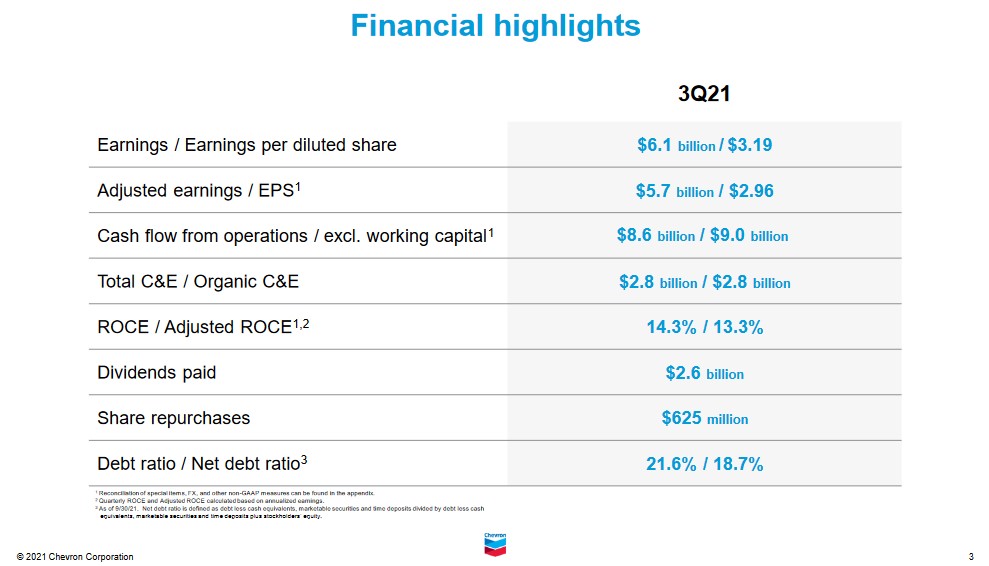Contents
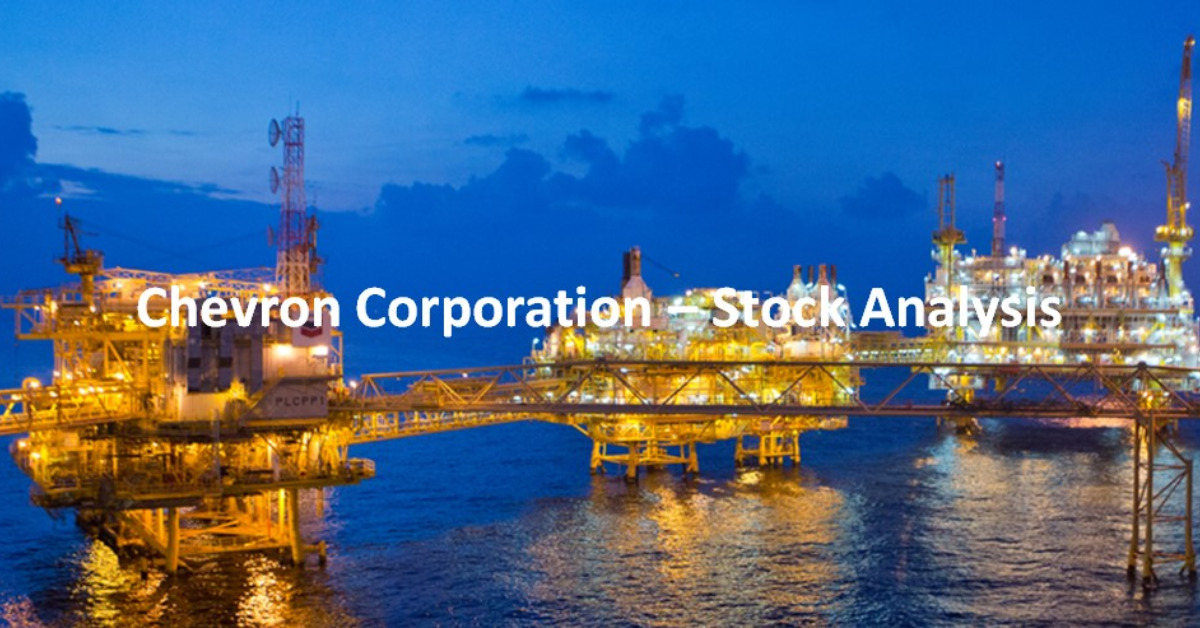
Previous Chevron Corporation (CVX) posts are accessible in the FFJ Archives.
In my most recent post, I concluded CVX shares were attractively valued and acquired additional shares in a ‘Core’ account in the FFJ Portfolio.
At the time of that post, CVX’s share price was ~$99. The share price is now ~$114.50 and with the October 29th release of Q3 and YTD 2021 results I revisit CVX to determine whether to acquire additional shares.
Chevron Corporation – Stock Analysis – The Road Ahead
The global annual temperature has increased in total by a little more than 1 degree Celsius since the Industrial Revolution. Our planet is now hotter than ever; 9 of the 10 warmest years since 1880 have occurred since 2005; the 5 warmest years on record have occurred since 2015.
Global warming occurs when carbon dioxide (CO2) and other air pollutants collect in the atmosphere and absorb sunlight and solar radiation that have bounced off the earth’s surface. Normally this radiation would escape into space. These pollutants can last for years to centuries in the atmosphere and trap the heat and cause the planet to get hotter. These heat-trapping pollutants (ie. carbon dioxide, methane, nitrous oxide, water vapour, and synthetic fluorinated gases) are known as greenhouse gases. This impact is called the greenhouse effect.
Different fuels emit different amounts of carbon dioxide (CO2) relative to the energy they produce when burned. The following table provides an overview of the pounds of CO2 emitted per million British thermal units (Btu) of energy for various fuels.
As much as we need to transition to green energy, it is in times like the present where we gain a greater appreciation of the extent to which the global economy is dependent upon a reliable and affordable energy supply every day. While we must transition to greener energy solutions, this transition will entail massive investment and it must be done in an orderly fashion.
In September, CVX announced an increase in its total capital spend on green initiatives from $3B to $10B between now and 2028.
The 4 big drivers that govern how rapidly this transition to green energy proceeds and whether the capital allocated to these initiatives will increase from $10B are:
- Policy – a carbon tax, for example, is the core policy for reducing and eventually eliminating the use of fossil fuels whose combustion is destabilizing and destroying our climate. This tax is levied on users of carbon fuels to pay for the climate damage caused by releasing carbon dioxide into the atmosphere. If set high enough, it becomes a powerful monetary disincentive that motivates switches to clean energy across the economy; it becomes more economically rewarding to move to non-carbon fuels and energy efficiency.
- Technology – the speed at which the costs be reduced on some of these green energy technologies.
- Innovation – how is technology to be integrated in ways not previously done to meet demands.
- Markets – Signals from equity and commodity markets that ultimately mobilize capital in the marketplace; massive amounts of capital will be required if the energy system is to be restructured.
Chevron Corporation – Stock Analysis – Financials
Q3 and YTD2021 Results
On October 29, 2021, CVX released Q3 and YTD results (Form 8-K and Earnings Presentation).
We can see that CVX had a very strong Q3 and its performance is remarkably different from Q3 2020; Q3 2021 earnings of $6.1B, or $3.19/share, is the highest reported earnings in more than 8 years.
Adjusted earnings of $5.7B, or $2.96/share, includes two special items:
- asset sales gains of $0.2B; and
- pension settlement costs of $0.081B.
These amounts are relatively immaterial.
CVX has become much more capital efficient. Cost efficiency and capital efficiency are essential to navigate commodity price cycles because it provides resilience through difficult periods and the ability to reap the rewards when markets are strong. This has been evident over the past several quarters and especially in Q3 when CVX generated record Free Cash Flow (FCF). Recent FCF is even higher than CVX’s strongest quarters in 2008 and 2011 when oil prices were well over $100 a barrel.
On the FCF front, CVX generated ~$6.7B in Q3 and ~$14.2B YTD. This has enabled CVX to reduce its net debt by $6.9B YTD. CVX’s net debt ratio is now below 19%.
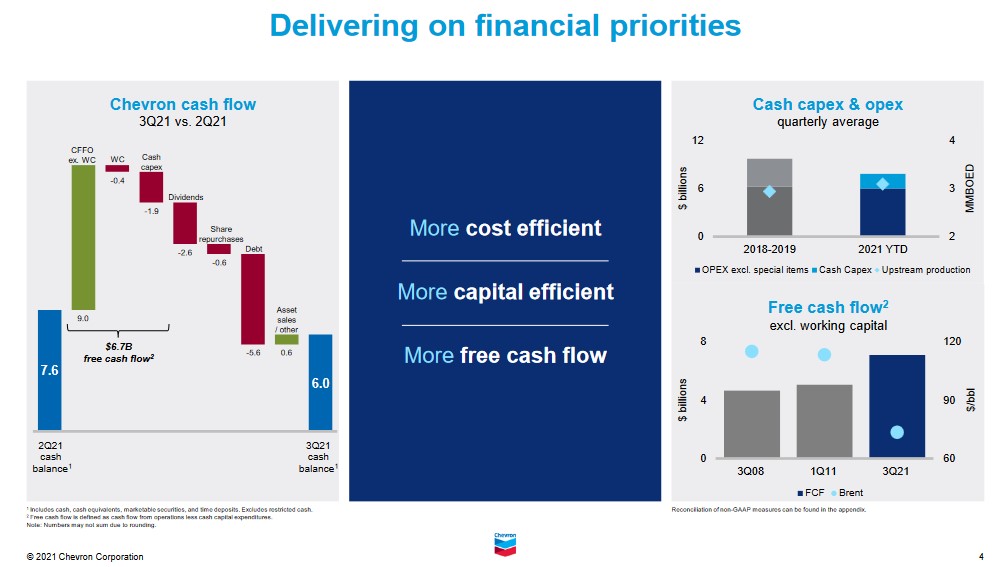
Source: CVX – Q3 2021 Earnings Presentation
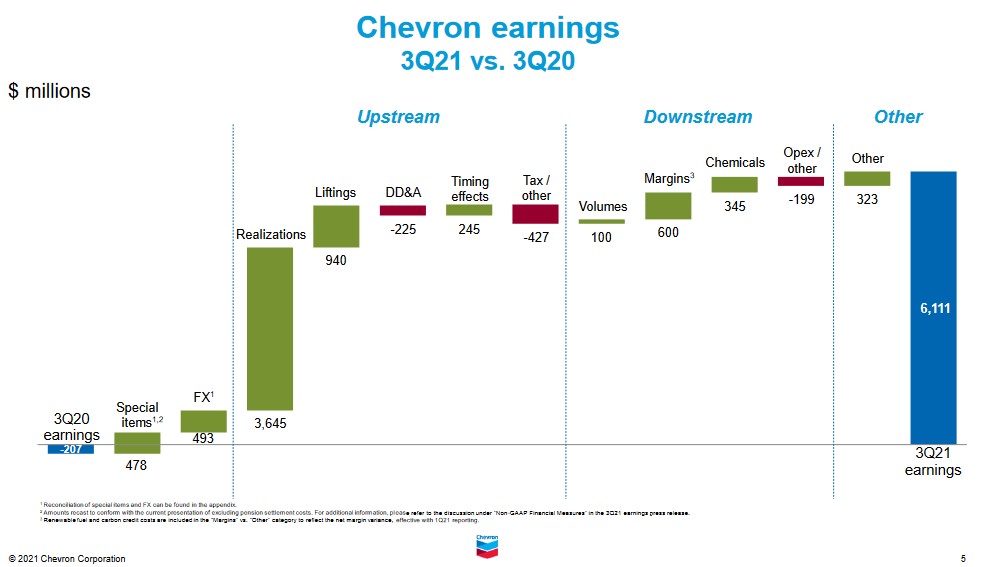
Source: CVX – Q3 2021 Earnings Presentation
Q4 2021 Guidance
On the Q3 earnings call, management indicated it expects to ramp up share repurchases and that in Q4 there will be the following quarter specific cash items:
- a return of capital from Angola LNG;
- TCO‘s first dividend in several years; and
- a federal income tax cash refund.
These items will not impact CVX’s profit and loss.
When Q2 results were released on July 30, CVX indicated capital and exploratory (C&E) expenses are down 32% from the prior year and FY2021 guidance is ~$13B. This is primarily due to lower spending at TCO and greater capital efficiency across the portfolio.
FY2021 C&E guidance is now revised to $12B – $13B. This is primarily due to COVID-related project spending being deferred into FY2022, lower non-operating capital expenditures in the Permian Basin, and continued capital efficiencies.
Chevron Corporation – Stock Analysis – Credit Ratings
At the end of FYE2020, CVX’s debt/net debt ratios were 25.2% and 22.7%. At the end of Q3 2021, they had improved to 21.6% and 18.7%; the 18.7% is below CVX’s 20% – 25% target net debt range.
CVX’s senior unsecured domestic currency debt ratings are:
- Moody’s: Aa2 (this is the middle tier of the high-grade investment-grade category).
- S&P Global: AA- (this is the bottom tier of the high-grade investment-grade category).
The outlook from both rating agencies is stable.
Both ratings define CVX as having a VERY STRONG capacity to meet its financial commitments. It differs from the highest-rated obligors only to a small degree.
Dividend and Dividend Yield
On October 29th, CVX announced its 3rd consecutive $1.34 quarterly dividend; refer to CVX’s dividend history.
When I wrote my previous post, CVX was trading at $99 and the dividend yield was ~5.4%. Shares are now trading at ~$114.50 and the yield is ~4.7%.
The 3rd $1.34 quarterly dividend is to be distributed December 10 to shareholders of record on November 18. We can also likely expect the 4th $1.34 quarterly dividend to be distributed mid-March 2022.
CVX is now generating very strong Free Cash Flow which gives it the flexibility to reward shareholders with further dividend increases. Management has repeatedly stated that returning excess cash to shareholders is a priority. I, therefore, anticipate CVX’s quarterly dividend will be increased by at least $0.10/share starting with the June 2022 dividend.
CVX’s diluted weighted average shares outstanding in FY2011 – FY2020 (in millions) are 2,001, 1,965, 1,932, 1,884, 1,875, 1,873, 1,898, 1,914, 1,895, and 1,870. This has increased to 1,921 in Q3 but the plan is to resume share repurchases; CVX only repurchased $0.6B in Q3 but this is expected to ramp up if FCF remains strong.
Share repurchases rank in priority behind:
- growing the dividend;
- investing in the business; and
- maintaining a strong balance sheet.
While CVX has repurchased shares in 14 of the last 18 years at an average price in the mid $80s, management has stated the plan is to maintain buybacks through the cycle. The oil and gas business is cyclical and wild swings in financial results are to be expected. With an improvement in the manner in which CVX is being managed, the intent is to be able to repurchase shares even during difficult periods.
Chevron Corporation – Stock Analysis – Valuation
CVX has generated YTD diluted EPS of $5.51 consisting of $0.72, $1.60, and $3.31 in Q1, Q2, and Q3 respectively. If we conservatively estimate CVX will generate $3.30 in Q4 then FY2021 diluted EPS should be ~$8.81. With shares trading at ~$114.50, the forward diluted PE is ~13.
By way of comparison, CVX’s FY2011 – FY2020 PE levels are 7.88, 8.12, 10.22, 10.33, 19.51, N/A, 36.50, 14.64, 17.29, and N/A. The years in which PE levels are N/A is when CVX reported a loss.
When I wrote my July 22nd post, I indicated that I expected the 27 brokers who provided FY2021 and FY2022 adjusted diluted EPS guidance would revise their figures upwards following the release of Q2 results. At the time of that post, CVX’s valuation based on adjusted diluted EPS estimates and a ~$99 share price was:
- FY2021: mean of $6.32 and a low/high range of $4.95 – $8.50. The forward adjusted diluted PE using the mean estimate is ~15.66 and ~14 if I use $7.
- FY2022: mean of $7.23 and a low/high range of $5.05 – $10.44. The forward adjusted diluted PE using the mean estimate is ~13.7 and ~11 if I use $9.
Shares are now trading at ~$114.50. The following earnings estimates are reflected in the 2 online trading platforms I use. There is a huge disparity in estimates and this is likely because some brokers are still revising their estimates; I expect the disparity will narrow over the coming days. For now, however, CVX’s forward adjusted diluted PE valuations are:
- FY2021: mean of $7.39 and a low/high range of $5.19 – $9.42 from 30 brokers. The forward adjusted diluted PE using the mean estimate is ~15.5 and ~12.2 if I use $9.42.
- FY2022: mean of $8.97 and a low/high range of $6.25 – $12.19 from 31 brokers. The forward adjusted diluted PE using the mean estimate is ~12.8 and ~9.4 if I use $12.19.
With such a disparity in earnings estimates, I think some brokers have yet to update their earnings estimates. I envision the low end of earnings estimates will be increased which would lower the forward adjusted diluted PE levels thereby making shares more attractively valued than they currently appear.
Chevron Corporation – Stock Analysis – Final Thoughts
I view CVX as the best major oil and gas company from an investment perspective and currently own 1954 shares.
I intend to add to my exposure but not while CVX is reporting very strong results.
Volatility is something investors need to accept when investing in an oil and gas company. While CVX is being managed to reduce the wild swings in quarterly results, the nature of the business is such that there will always be peaks and troughs. CVX’s share price will likely take a hit when industry conditions once again become unfavourable. I will wait until such time this happens before adding to my CVX exposure.
I wish you much success on your journey to financial freedom!
Note: Please send any feedback, corrections, or questions to finfreejourney@gmail.com.
Disclosure: I am long CVX.
Disclaimer: I do not know your circumstances and am not providing individualized advice or recommendations. I encourage you not to make any investment decisions without conducting your research and due diligence. You should also consult your financial advisor about your specific situation.
I wrote this article myself and it expresses my own opinions. I am not receiving compensation for it and have no business relationship with any company whose stock is mentioned in this article.


